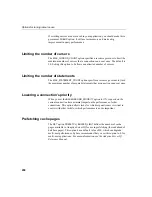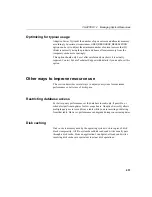
Indexing tips
452
Operating systems use two different methods to allocate memory to disk cache:
fixed and dynamic. A preset amount of memory is used in a fixed allocation;
usually a 10–15 percent memory allocation is set aside. The operating system
usually manages this workspace using a LRU (least recently used) algorithm.
For a dynamic allocation, the operating system determines the disk cache
allocation as it is running. The goal is to keep as much memory in active use as
possible, balancing the demand for real memory against the need for data from
disk.
Using RAM disk
When RAM disk is implemented, the operating system views a portion of
memory as a disk drive. Disk operations involving RAM disk are very fast.
When files are placed on RAM disk, the performance of processes using those
files can improve dramatically. Primary candidates for RAM disks are
programs and temporary files.
Warning!
This is not recommended for database files or transaction log files.
Database integrity may be compromised if these files are placed on RAM disk.
Indexing tips
The following sections give some tips for selecting and managing indexes. See
Chapter 4, “Adaptive Server IQ Indexes” for more information on these topics.
Picking the right index type
It is important to pick the correct index type for your column data. Adaptive
Server IQ provides some indexes automatically—a default index on all
columns that optimizes projections, and an
HG
index for
UNIQUE
and single-
column
PRIMARY KEY
columns. While these indexes are useful for some
purposes, you need other indexes to process certain queries as quickly as
possible. Adaptive Server IQ chooses the best index type for you when there
are multiple index types for a column.
Summary of Contents for Adaptive Server IQ 12.4.2
Page 1: ...Administration and Performance Guide Adaptive Server IQ 12 4 2 ...
Page 16: ...xvi ...
Page 20: ...Related documents xx ...
Page 40: ...Compatibility with earlier versions 20 ...
Page 118: ...Troubleshooting startup shutdown and connections 98 ...
Page 248: ...Importing data by replication 228 ...
Page 306: ...Integrity rules in the system tables 286 ...
Page 334: ...Cursors in transactions 314 ...
Page 396: ...Users and permissions in the system tables 376 ...
Page 438: ...Determining your data backup and recovery strategy 418 ...
Page 484: ...Network performance 464 ...
Page 500: ...System utilities to monitor CPU use 480 ...
Page 514: ...Characteristics of Open Client and jConnect connections 494 ...
Page 536: ...Index 516 ...
















































